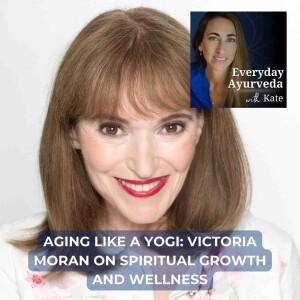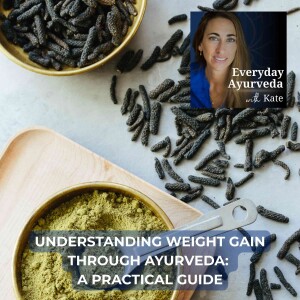Everyday Ayurveda with Kate
Welcome to Everyday Ayurveda, a podcast by Kate O’Donnell, renowned Ayurvedic practitioner, bestselling author, and founder of the Ayurvedic Living Institute. Join Kate as she demystifies the ancient wisdom of Ayurveda and translates it into practical, everyday practices for modern living. In each episode, Kate shares her deep knowledge and personal experiences from over two decades of studying Ayurveda in India. Whether you’re new to Ayurveda or a seasoned practitioner, you’ll discover valuable insights on diet, lifestyle, self-care, and holistic health. Everyday Ayurveda is your go-to resource for integrating the timeless principles of Ayurveda into your daily routine, fostering a life of balance, health, and happiness. Subscribe now and start your journey towards radiant well-being with Kate O’Donnell. Listen, learn, and transform with Everyday Ayurveda – because true health begins with the choices we make every day.
Episodes

Wednesday Aug 06, 2025
Wednesday Aug 06, 2025
In this practical and passionate solo episode, Kate O’Donnell unpacks the Ayurvedic ritual of oil massage—known as Abhyanga—and shares everything you need to know to make it a regular part of your wellness routine. Whether you’re looking to improve your skin, calm your nerves, age with grace, or detox gently, this episode offers a complete guide to integrating this timeless practice into your life. Kate walks you through the how, why, and when of oil massage, including shortcuts, contraindications, and her favorite oils for every body type.
What You’ll Learn
How Ayurvedic oil massage nourishes skin, nerves, and the lymphatic system
Why morning is the ideal time for Abhyanga—and when evening is better
The difference between sesame, coconut, almond, and herbal oils
A simple step-by-step massage guide (including the “quickie” version)
When not to oil (hint: indigestion, menstruation, and more)
Why sneha means both oil and love in Sanskrit—and what that means for your practice
How to upgrade your shower routine into a healing ritual
Travel tips for keeping your oiling practice alive on the go
Common misconceptions about using grocery store oils
Links to Kate’s favorite oils (with discount codes!)
Resources + Links
🌿 Kate’s Favorites Page (Massage Oils + Discounts): https://ayurvedicliving.institute/our-favorites
📩 Contact Kate: hello@ayurvedicliving.institute
📸 Instagram: @kateodonnell.ayurveda
Call to Action
Feeling inspired? Try oil massage this week and tell us how it goes! Send your questions or share your experience via Instagram @kateodonnell.ayurveda or by email. And stay tuned for next week’s episode on Ayurvedic hair health—yes, more oils are involved!
Health Disclaimer
The information shared on Everyday Ayurveda with Kate is for educational purposes only and is not a substitute for medical advice, diagnosis, or treatment. Always consult a qualified healthcare provider before making changes to your diet, supplements, or wellness routine.
Connect with Kate: https://www.healwithkate.org Ayurvedic Living Institute Membership: https://ayurvedicliving.institute/membership Cleanse Leader Training: https://ayurvedicliving.institute/cleanse-leader-training Deep Winter Self-Care Workshop: https://courses.ayurvedicliving.institute/courses/self-care-workshop-deep-winterWomen's Health Collection: https://courses.ayurvedicliving.institute/collections/womens-healthhttps://courses.ayurvedicliving.institute/products/courses/copy-of-fall-community-cleanse-2024Gift Guide: https://courses.ayurvedicliving.institute/products/digital_downloads/gift-guide

Wednesday Jul 30, 2025
Wednesday Jul 30, 2025
Why is Ayurveda so obsessed with oils? In this beautifully textured conversation, Kate O’Donnell welcomes Osi Mizrahi—founder of OSI Oils—to explore the sacred role of oils in Ayurvedic practice. From cooking herbs for three days to customizing breast, belly, and hair oils, Osi shares her personal healing journey, business wisdom, and why oil is truly love (Sneha). You’ll learn what oils to use, how to use them, and even how to keep your sheets and shower clean in the process. This episode is an inspiring celebration of Ayurvedic ritual, slow beauty, and living from the inside out.
In This Episode with Osi Mizrahi:
What makes Ayurvedic oil preparation so unique
Why Sneha means both “oil” and “love” in Sanskrit
The importance of warming oil, self-massage, and ritual
How Ayurvedic oils support digestion, hormones, skin, and nervous system regulation
Osi’s favorite tips for keeping your linens and pipes clean
The emotional and spiritual benefits of daily oiling
A candid discussion on authenticity, entrepreneurship, and the business of healing
Guest Bio:
Osi Mizrahi is the founder of OSI Oils, a wellness brand rooted in Ayurvedic tradition and slow beauty. Her hand-crafted oils are made in small batches using classical methods and ethically sourced herbs. After a deeply personal health journey, Osi became passionate about making Ayurvedic practices accessible, sensual, and joyful. She also coaches women entrepreneurs and is the author of the upcoming memoir Desert Flower.
Relevant Links:
Shop OSI Oils: https://www.osioils.com/?ref_cca=kateodonnell
Osi’s Coaching + Book: https://osimizMizrahi.com/
Follow Osi on Instagram: @osioils
Love what you heard? Be sure to subscribe, leave a review, and explore more Ayurvedic practices in Kate’s bestselling books and courses.
Connect with Kate: https://www.healwithkate.org Ayurvedic Living Institute Membership: https://ayurvedicliving.institute/membership Cleanse Leader Training: https://ayurvedicliving.institute/cleanse-leader-training Deep Winter Self-Care Workshop: https://courses.ayurvedicliving.institute/courses/self-care-workshop-deep-winterWomen's Health Collection: https://courses.ayurvedicliving.institute/collections/womens-healthhttps://courses.ayurvedicliving.institute/products/courses/copy-of-fall-community-cleanse-2024Gift Guide: https://courses.ayurvedicliving.institute/products/digital_downloads/gift-guide

Wednesday Jul 23, 2025
Wednesday Jul 23, 2025
In this powerful roundtable discussion, Kate O’Donnell is joined by three renowned practitioners—Dr. Scott Blossom, Jennifer Boyd, and Kimberly Giunta—to explore how perimenopause and menopause affect the heart, brain, hormones, and spirit. Together, they challenge conventional narratives, emphasizing that this sacred transition isn’t something to fix, but to support and honor. From hormone replacement therapy and bioidenticals to the role of self-breast massage, fiber intake, and spiritual trust, this conversation offers a truly integrative view of midlife wellbeing.
In this episode, you’ll discover:
Why cognitive and cardiovascular shifts occur in midlife
The surprising connection between estrogen and brain health
How to interpret the language of the menopausal heart
The truth about hormone replacement therapy (and what most women aren’t being told)
Ayurvedic, Chinese Medicine, and Functional Medicine perspectives on midlife care
How self-breast massage can enhance hormonal balance and emotional wellbeing
The importance of fiber, the microbiome, and metabolic flexibility in cognitive health
Why listening is a healing act—and how to cultivate it
How faith, trust, and community support our transformation
Guest Bios:
Dr. Scott Blossom is a Doctor of Chinese Medicine, Ayurvedic practitioner, yoga and somatics teacher, and expert in evidence-based nutrition. He specializes in cognitive decline, Alzheimer’s prevention, and holistic aging.
Jennifer Boyd, PA is an ecosychologist and integrative medicine practitioner with deep roots in women’s reproductive health, functional medicine, and psychedelic-assisted therapy.
Kimberly Giunta is a clinical Ayurvedic specialist and somatic healer who bridges classical Ayurveda with spiritual and emotional healing. Her work focuses on the wisdom of the heart, ritual, and midlife embodiment.
Relevant Links:
Kripalu Workshop- The Menopausal Heart and Brain: https://kripalu.org/presenters-programs/menopausal-heart-and-brain-ayurveda-yoga-and-functional-medicine-approaches
The Simple Breast Massage Protocol: https://www.myayurvedamentor.com/simple-breast-massage-protocol
Jennifer's Midlife Magic: Free Journal prompts for Deep Inner Listening: https://boydwellness.vipmembervault.com/products/offers/view/1185585
Kimberly on IG: @kimberlyanngiunta
Jennider on IG: @boydwellness
Scott on IG: @docblossom
Call to Action:
If this episode resonates with you, please share it with a friend going through midlife transitions. And don’t forget to leave a rating and review wherever you listen to podcasts!
Connect with Kate: https://www.healwithkate.org Ayurvedic Living Institute Membership: https://ayurvedicliving.institute/membership Cleanse Leader Training: https://ayurvedicliving.institute/cleanse-leader-training Deep Winter Self-Care Workshop: https://courses.ayurvedicliving.institute/courses/self-care-workshop-deep-winterWomen's Health Collection: https://courses.ayurvedicliving.institute/collections/womens-healthhttps://courses.ayurvedicliving.institute/products/courses/copy-of-fall-community-cleanse-2024Gift Guide: https://courses.ayurvedicliving.institute/products/digital_downloads/gift-guide

Wednesday Jul 16, 2025
Wednesday Jul 16, 2025
In this solo episode, Kate O’Donnell invites you into a candid conversation on wellness shaming, the complexities of hormone replacement therapy (HRT), and the true Ayurvedic perspective on supplementation. With equal parts compassion and clarity, Kate offers her evolving thoughts on what it means to feel confident in your health choices, how to engage with controversial wellness topics without judgment, and why prana—not pills—may be your most powerful daily nutrient.
Whether you’re navigating perimenopause, overwhelmed by conflicting wellness advice, or just wondering where Ayurveda fits in a supplement-saturated world, this episode offers a grounding voice of wisdom and truth.
🔍 Episode Breakdown
Intro to “Wellness Shaming” and how it subtly influences our health choices
Why this podcast is a shame-free, judgment-free zone
Ayurveda’s definition of true confidence and decision-making from sattva
A personal, evolving reflection on Hormone Replacement Therapy (HRT)
The Ayurvedic concern about external dependencies vs internal balance
Prana: your primary nutrient and how it trumps most supplements
How modern wellness often ignores the subtle body
Why bloodwork, bio-identicals, and lab-made vitamins can help—but only if used wisely
The importance of seasonal cleansing, rest cycles, and breathwork in self-regulation
Kate’s honest promise: to be real, responsive, and co-create this space with YOU
👤 About Kate O’Donnell
Kate O’Donnell is the host of Everyday Ayurveda, founder of The Ayurvedic Living Institute, and a renowned author of four bestselling books including Everyday Ayurveda for Women’s Health. With over 25 years of experience in Ayurveda and yoga, Kate helps students and clients integrate time-tested practices into modern life for better digestion, balanced hormones, restful sleep, and deeper connection to purpose.
Explore more at: https://healwithkate.org
📣 Call to Action
Are you ready to tune out the noise and start trusting your body’s wisdom again?
📬 Email Kate with your questions or reflections at hello@healwithkate.org
📲 Follow on Instagram @kateodonnell.ayurveda
📚 Grab a copy of Everyday Ayurveda for Women’s Health
💻 Join a cleanse or course to realign with nature and nourish your prana
⚠️ Health Disclaimer
The information shared on Everyday Ayurveda with Kate is for educational purposes only and is not a substitute for medical advice, diagnosis, or treatment. Always consult a qualified healthcare provider before making changes to your diet, supplements, or wellness routine.
Connect with Kate: https://www.healwithkate.org Ayurvedic Living Institute Membership: https://ayurvedicliving.institute/membership Cleanse Leader Training: https://ayurvedicliving.institute/cleanse-leader-training Deep Winter Self-Care Workshop: https://courses.ayurvedicliving.institute/courses/self-care-workshop-deep-winterWomen's Health Collection: https://courses.ayurvedicliving.institute/collections/womens-healthhttps://courses.ayurvedicliving.institute/products/courses/copy-of-fall-community-cleanse-2024Gift Guide: https://courses.ayurvedicliving.institute/products/digital_downloads/gift-guide

Wednesday Jul 09, 2025
Wednesday Jul 09, 2025
This special replay episode features a timeless and transformative conversation between Kate O’Donnell and Emma Balnaves, senior teacher of Shadow Yoga. Originally released a year ago, this episode continues to resonate with women navigating life’s big transitions—from menstruation to menopause and beyond.
Emma shares wisdom from her decades of daily yoga practice, weaving together Ayurveda, subtle body awareness, and feminine life cycles. You’ll hear her speak frankly about perimenopause, aging, blood health, and how women’s bodies require a different approach to movement, intuition, and rest.
This is more than a yoga conversation—it’s an invitation to evolve your practice with compassion, strength, and ritual.
💫 If you’re listening in real time, you’ll also want to know: Kate and Emma are teaching a Yoga for Women workshop in Boston, September 2025. Details and registration info are linked below!
🔍 What You’ll Learn in This Episode
What Shadow Yoga is—and how it differs from mainstream yoga
Why menstruation, pregnancy, and menopause are each unique opportunities for energetic transformation
The Ayurvedic importance of blood and reproductive energy across the female lifespan
How prana, agni, and intuitive awareness shift after 35 (and why it matters)
Emma’s personal insights on menopause, grief, and spiritual practice
Tools to support your body during hormonal and energetic transitions
Why ritual, not rigor, is the real key to a sustainable women’s practice
👤 Guest Bio: Emma Balnaves
Emma Balnaves is a senior teacher and co-founder of the Shadow Yoga school, an approach to yoga rooted in the ancient principles of Hatha Yoga and the energetic body. For over two decades, Emma has worked with students around the globe, especially women seeking a deeper connection to their practice through seasonal, intuitive, and energetic awareness. Her teachings emphasize self-inquiry, strength from within, and honoring the life cycles we move through—especially for women in midlife and beyond.
🌐 Learn more about Emma’s work: https://shadowyoga.com
📖 Read her article Yoga for Women (linked in Kate’s book and the show notes below)
🔗 Resources & Links
🔗 Register for the Yoga for Women Workshop with Kate + Emma (Boston, September 2025): https://shadowyogaboston.com/program.html
📄 Yoga for Women article by Emma Balnaves
📘 The Everyday Ayurveda Guide to Self-Care by Kate O’Donnell
🌐 Shadow Yoga Website: https://shadowyoga.com
📣 Call to Action
Loved this conversation? Share it with a friend or tag @kateodonnell.ayurveda on Instagram with your takeaways.
And if you’re ready to evolve your yoga practice to meet your real life—body, hormones, intuition and all—join Kate and Emma in Boston this September for the Yoga for Women workshop.
This episode is a replay, but its wisdom is more relevant than ever.
⚠️ Health Disclaimer
The information shared on Everyday Ayurveda with Kate is for educational purposes only and is not a substitute for medical advice, diagnosis, or treatment. Always consult a qualified healthcare provider before making changes to your diet, supplements, or wellness routine.
Connect with Kate: https://www.healwithkate.org Ayurvedic Living Institute Membership: https://ayurvedicliving.institute/membership Cleanse Leader Training: https://ayurvedicliving.institute/cleanse-leader-training Deep Winter Self-Care Workshop: https://courses.ayurvedicliving.institute/courses/self-care-workshop-deep-winterWomen's Health Collection: https://courses.ayurvedicliving.institute/collections/womens-healthhttps://courses.ayurvedicliving.institute/products/courses/copy-of-fall-community-cleanse-2024Gift Guide: https://courses.ayurvedicliving.institute/products/digital_downloads/gift-guide

Wednesday Jul 02, 2025
Wednesday Jul 02, 2025
Is your morning cup of coffee a life-enhancing ritual—or a daily stressor for your body? In this candid solo episode, Kate O’Donnell breaks down the Ayurvedic perspective on coffee, caffeine, and the signals your body may be sending you about both. From bloat to breakouts, adrenal fatigue to mood swings, Kate explores how the bitter brew impacts digestion, hormones, and emotional well-being—especially during perimenopause and beyond.
Whether you thrive on a daily dose of java or suspect it might be messing with your system, this episode offers thoughtful insight, practical strategies, and a gentle invitation to reconsider your relationship with caffeine. You’ll also discover nourishing alternatives like dandelion root, turmeric lattes, and the Ayurvedic staple triphala—plus how to enjoy the joie de vivre of coffee without compromising your health.
In This Episode, You’ll Learn:
Why coffee works for some body types—and backfires for others
Four clear signs coffee might not be working for your system
The Ayurvedic lens on caffeine, digestion, skin health, and mood
How perimenopause and adrenal fatigue affect caffeine tolerance
The pros and cons of protein coffee and when to drink your brew
Seasonal considerations for coffee consumption
Herbal alternatives that satisfy the bitter taste (without the burnout)
How to quit or cut back without painful caffeine withdrawal
The importance of organic beans and paper filters for safe sipping
Why pleasure matters just as much as science when it comes to your morning ritual
Mentioned in the Episode:
Dandy Blend (roasted dandelion + chicory alternative)
Triphala powder for digestion and morning elimination
Turmeric golden milk and turmeric lattes
Organic, naturally decaffeinated coffee
Claudia Welch’s work on coffee and female reproductive health
Call to Action:
Take a few days to observe how your body responds to coffee. Does it energize and steady you—or throw off your digestion, skin, or mood? Let Kate know your experience over on Instagram @kateodonnellayurveda or by leaving a review and sharing the episode with a friend who’s very into their pour-over.
Listen + Subscribe:
You can listen and subscribe to Everyday Ayurveda with Kate on Apple Podcasts, Spotify, or wherever you tune into your favorite shows.
Health Disclaimer:
The information shared on Everyday Ayurveda with Kate is for educational purposes only and is not a substitute for medical advice, diagnosis, or treatment. Always consult a qualified healthcare provider before making changes to your diet, supplements, or wellness routine.
Connect with Kate: https://www.healwithkate.org Ayurvedic Living Institute Membership: https://ayurvedicliving.institute/membership Cleanse Leader Training: https://ayurvedicliving.institute/cleanse-leader-training Deep Winter Self-Care Workshop: https://courses.ayurvedicliving.institute/courses/self-care-workshop-deep-winterWomen's Health Collection: https://courses.ayurvedicliving.institute/collections/womens-healthhttps://courses.ayurvedicliving.institute/products/courses/copy-of-fall-community-cleanse-2024Gift Guide: https://courses.ayurvedicliving.institute/products/digital_downloads/gift-guide

Wednesday Jun 25, 2025
Wednesday Jun 25, 2025
What if the key to resolving your hormonal imbalance, easing perimenopause symptoms, and supporting detoxification was as simple as eating more beans?
In this episode, Kate is joined by renowned nutritionist and biochemist Karen Hurd—affectionately known as “The Bean Queen”—to explore how soluble fiber plays a vital role in removing toxins and excess hormones from the body. This deep-dive into the biochemical detox process is packed with actionable wisdom, from understanding bile recirculation to rebuilding adrenal health, and what your caffeine habit has to do with hot flashes and energy crashes.
Karen’s powerful origin story, which began with saving her daughter from pesticide poisoning, led her down a path of uncovering life-saving truths about the liver’s detox systems, hormonal regulation, and how soluble fiber can change everything—especially for women in midlife.
Whether you’re considering HRT, struggling with symptoms of estrogen dominance, or just looking for one thing to do to feel better—this is a can’t-miss conversation.
What You’ll Learn:
The three detox systems of the body and how they work
How soluble fiber helps remove excess hormones and toxins
Why your caffeine habit could be hurting your adrenals
A biochemical explanation for hot flashes and hormonal swings
Why Americans are fiber-deficient—not protein-deficient
Simple steps to safely introduce more beans into your diet
How fragrance, caffeine, and even chocolate impact hormone health
The hidden risks of hormone replacement therapy
Guest Bio:
Karen Hurd, MS, MPH, is a biochemist, nutritional consultant, and functional health pioneer known for her groundbreaking work on the role of soluble fiber in detoxification and hormonal health. Her practice was born out of personal crisis: when her 18-month-old daughter was poisoned by an organophosphate, conventional medicine gave up. Karen turned to science, food, and fierce maternal determination to save her child’s life—and succeeded. She’s been teaching and practicing for over 30 years and is the creator of the Bean Protocol. Learn more at karenhurd.com.
Resources + Links:
Karen’s Courses by Condition: karenhurd.com
Follow Karen’s podcast interviews on women’s health and detox protocols via her site
Email Kate: hello@ayurvedicliving.institute
Kate’s books and programs: healwithkate.org
Health Disclaimer:
The information shared on Everyday Ayurveda with Kate is for educational purposes only and is not a substitute for medical advice, diagnosis, or treatment. Always consult a qualified healthcare provider before making changes to your diet, supplements, or wellness routine.
Connect with Kate: https://www.healwithkate.org Ayurvedic Living Institute Membership: https://ayurvedicliving.institute/membership Cleanse Leader Training: https://ayurvedicliving.institute/cleanse-leader-training Deep Winter Self-Care Workshop: https://courses.ayurvedicliving.institute/courses/self-care-workshop-deep-winterWomen's Health Collection: https://courses.ayurvedicliving.institute/collections/womens-healthhttps://courses.ayurvedicliving.institute/products/courses/copy-of-fall-community-cleanse-2024Gift Guide: https://courses.ayurvedicliving.institute/products/digital_downloads/gift-guide

Wednesday Jun 18, 2025
Wednesday Jun 18, 2025
Are you feeling irritable, inflamed, bloated, or just plain overheated? Summer brings a surge of energy and sunlight—but it can also push your body out of balance. In this solo episode of Everyday Ayurveda with Kate, Kate O’Donnell breaks down what’s happening in your body during the summer season, and how to work with nature (not against it) using time-tested Ayurvedic principles. Whether you’re dealing with digestion issues, summer skin flare-ups, or mood swings, Kate offers practical, soothing, and empowering strategies to help you feel light, clear, and calm all season long.
In This Episode, You’ll Learn:
Why summer weakens the body in Ayurveda—and what you can do about it
Signs your Pitta dosha may be out of balance (hello, rashes, mood swings & acid indigestion)
How to adjust your diet to support cooling, moisture-rich digestion
The best and worst foods to eat in summer (spoiler: skip the fries)
Ayurvedic hydration hacks, including how to make your own herbal water
How air conditioning affects your doshas (and how to counteract it)
Practical food swaps, herbal remedies, and lifestyle upgrades for summer
Simple body care tips that keep you cool from the outside in
Why fruits, especially plums, are your best friend this season
How to reduce internal inflammation without giving up delicious food
Key Takeaways:
☀️ Summer increases the Pitta dosha, which can lead to inflammation, irritability, and digestive distress if not managed properly.
🥥 Cooling, hydrating foods like coconut, cucumber, and dark berries help balance heat.
🌀 Avoiding fried foods, heavy meats, strong ferments, and coffee can make a dramatic difference.
💧 Herbal waters, aloe juice, and smart hydration techniques support energy and digestion.
🛁 External practices like skipping antiperspirant and using aloe or coconut oil help regulate heat through the skin.
Kate’s Summer Favorites Mentioned in This Episode:
Cooling Herbs & Spices: Fennel, coriander, mint, cilantro, turmeric
Hydration Helpers: Aloe juice, cucumber water, lime & pink salt DIY electrolyte
Digestive Aids: Triphala tea, fresh coconut, cooked greens, and legumes
Body Care Tips: Coconut oil for dry climates; aloe gel for humid heat
Smart Meal Ideas: Red lentils with quinoa, coconut-based summer soups, lightly steamed veggies
Connect with Kate:
🌿 Follow Kate on Instagram: @kateodonnell.ayurveda
🌿 Visit the Ayurvedic Living Institute for courses & resources
🌿 Shop Kate’s books on seasonal eating and Ayurvedic self-care wherever books are sold
Subscribe & Review:
If you loved this episode, please consider subscribing and leaving a 5-star review on your favorite podcast platform. It helps more people discover Ayurveda—and supports this free offering. Thank you for being part of our healing community!
Connect with Kate: https://www.healwithkate.org Ayurvedic Living Institute Membership: https://ayurvedicliving.institute/membership Cleanse Leader Training: https://ayurvedicliving.institute/cleanse-leader-training Deep Winter Self-Care Workshop: https://courses.ayurvedicliving.institute/courses/self-care-workshop-deep-winterWomen's Health Collection: https://courses.ayurvedicliving.institute/collections/womens-healthhttps://courses.ayurvedicliving.institute/products/courses/copy-of-fall-community-cleanse-2024Gift Guide: https://courses.ayurvedicliving.institute/products/digital_downloads/gift-guide

Wednesday Jun 11, 2025
Wednesday Jun 11, 2025
In this episode of Everyday Ayurveda with Kate, we sit down with the wise and inspiring Victoria Moran—Oprah-featured author of Age Like a Yogi and host of the Main Street Vegan Podcast. At 75, Victoria shares honest reflections on what it truly means to age like a yogi in a youth-obsessed culture. Together, she and Kate unpack topics including Ayurveda’s role in healthy aging, the importance of strength training, the evolution of yoga, and finding authenticity in the digital age. This conversation is a gentle, humorous, and insightful invitation to embrace aging with grace, courage, and curiosity.
Episode Breakdown
Introduction to Victoria Moran: Author of Age Like a Yogi, long-time yoga practitioner, and advocate for compassionate living.
What It Means to Age Like a Yogi: Spiritual perspectives on aging with awareness and grace.
Ayurveda and Aging: How Ayurveda supports both the physical and spiritual journey of getting older.
Strength Training and Asana: Why Victoria includes weight training in her wellness regimen—and how to adapt yoga practice as joints become more Vata.
The Evolution of Yoga: Victoria’s stories from the early days of yoga in America to today’s digital yoga world.
Navigating Appearance Culture: Reflections on self-image, video culture, and authenticity.
Living Authentically: First-person vs. third-person living, and reclaiming presence and truth in modern life.
Vegan Ayurveda: Victoria’s perspective on aligning ahimsa with a plant-based lifestyle.
Closing Rituals: Victoria’s simple but powerful evening self-care practices.
Guest Bio
Victoria Moran is the author of 14 books, including Age Like a Yogi and Main Street Vegan, and has practiced yoga since her teens. She hosts the Main Street Vegan Podcast and produced the documentary A Prayer for Compassion. With 30 years of experience studying Ayurveda, Victoria brings a compassionate, grounded perspective to aging, spirituality, and holistic health. She lives in New York City and teaches around the world.
🔗 Main Street Vegan Podcast
🔗 Instagram: @victoriamoranauthor
🔗 Age Like a Yogi (Book): Link to purchase
Relevant Links
Kate O’Donnell: healwithkate.org
Victoria’s Book: Age Like a Yogi
Additional Resources: Vegan Ayurveda Recipe Guide
Call to Action
If you enjoyed this episode, please subscribe, rate, and review on your favorite podcast platform. Share with a friend who’s navigating aging, yoga, or Ayurveda—and let’s grow older together with grace and authenticity.
Connect with Kate: https://www.healwithkate.org Ayurvedic Living Institute Membership: https://ayurvedicliving.institute/membership Cleanse Leader Training: https://ayurvedicliving.institute/cleanse-leader-training Deep Winter Self-Care Workshop: https://courses.ayurvedicliving.institute/courses/self-care-workshop-deep-winterWomen's Health Collection: https://courses.ayurvedicliving.institute/collections/womens-healthhttps://courses.ayurvedicliving.institute/products/courses/copy-of-fall-community-cleanse-2024Gift Guide: https://courses.ayurvedicliving.institute/products/digital_downloads/gift-guide

Wednesday Jun 04, 2025
Wednesday Jun 04, 2025
This episode of Everyday Ayurveda with Kate O’Donnell unpacks the complex relationship between weight gain and the Ayurvedic doshas. Kate explains the different types of weight gain—Vata, Pitta, Kapha, and toxins (ama)—and shares practical tips for addressing each type. She dives deep into the root causes of weight gain, from stress and metabolic dysfunction to diet and lifestyle choices. Whether you’re feeling stuck with extra pounds or simply curious about how Ayurveda interprets weight gain, this episode offers grounded wisdom, clear guidance, and actionable steps to support your journey toward balance and well-being.
Episode Breakdown:
Introduction to Ayurveda and Weight Gain: Why Ayurveda views weight gain as more than calories in vs. out.
Types of Weight Gain:
Kapha Type: Heaviness, stickiness, slow metabolism.
Pitta Type: Stress-related inflammation and cortisol-driven weight gain.
Vata Type: Puffiness from irregular eating and stress.
Toxins (Ama): Metabolic waste impacting digestion.
Practical Solutions:
Spices like cumin, coriander, ginger, black pepper, turmeric.
Meal timing that supports digestion and metabolic health.
The importance of stress management and rest.
Holistic Advice: How lifestyle and emotional health influence weight.
Call to Action: Stay connected with Kate at https://www.instagram.com/kateodonnell.ayurveda/ and email hello@ayurvediclivinginstitute.com.
Connect with Kate: https://www.healwithkate.org Ayurvedic Living Institute Membership: https://ayurvedicliving.institute/membership Cleanse Leader Training: https://ayurvedicliving.institute/cleanse-leader-training Deep Winter Self-Care Workshop: https://courses.ayurvedicliving.institute/courses/self-care-workshop-deep-winterWomen's Health Collection: https://courses.ayurvedicliving.institute/collections/womens-healthhttps://courses.ayurvedicliving.institute/products/courses/copy-of-fall-community-cleanse-2024Gift Guide: https://courses.ayurvedicliving.institute/products/digital_downloads/gift-guide






